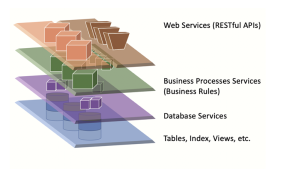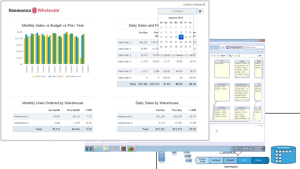
As an IT leader, just keeping the lights on is not enough in these tumultuous times. The recent pandemic and the emergence of a new baseline for “normal” has pushed companies to provide effective digital experiences and enable remote work, while dealing with both revenue loss and fewer resources.
Understanding what you have in terms of IT and focusing your efforts can help you drive the most value, while staying aligned with business goals. Finding just the right balance between addressing modernization needs and working within reduced budgets is a key determinant of your plan’s success.
Your roadmap for modernizing IBM i applications can include solutions for web, APIs and cloud as well as agile development processes and an organizational commitment to change. Making pragmatic decisions and developing the right plan for you is critical. This article talks about some key areas where you can make smaller investments to move toward greater modernization.
Understanding Where to Start
All modernization efforts are not made equal. When you’re planning a roadmap to modernize your legacy applications, it is crucial to prioritize changes that can deliver immediate value to the business. The quick wins at the top of your list should be those that the business is looking for and can get behind.
Most IBM i environments have thousands of programs and tables. It is important to gain a technical understanding of what you have in your portfolio and then organize it. This can help you build a staged plan, which then becomes the launch point for your modernization roadmap. This strategic building and layering also can help you demonstrate the incremental value delivered by these modernization efforts to the company.
Business Benefits of Application Modernization
It is important for the stakeholders to understand the benefits that come with modernizing your i.
Here are a few of them:
- Business continuity: Attracting skilled resources and ensuring business continuity with modern languages, architecture and tooling. This is key for most organizations running older IBM i applications.
- Agility and faster time-to-market: Delivering fixes to the business faster via tooling ecosystems (DevOps) and replacing monolithic applications with smaller, more reusable components that are easier to manage.
- Industry leadership: Being the first-to-market new capabilities through innovation and experimentation, either leading disruption in your industry or responding to it.
- Easy integration: Improving integration with partners, suppliers and customers through APIs and service enablement.
- Compliance: Improving processes to make them more secure and audit ready.
Driving Business Value with Quick Wins
Resist the temptation to start with changes that are easy or quick to do: the ideal quick win is one that is not only technically feasible, but also offers measurable value to the business.
As a direct result of your modernization efforts:
- Can the business interact with data differently?
- Are there direct or indirect improvements in customer interactions?
- Will the business gain new capabilities?
- Does this streamline a business process – make things more efficient, decrease labor, reduce cost, or make it easier to onboard new people/resources?
- Does it address a longstanding pain in a process flow?
These are a few questions that you can ask to arrive at a quick win strategy that is ideal for both IT and the business.
Adopting the Enterprise Design Thinking Approach
Enterprise Design Thinking, a crucial tool, is a framework for engaging with the business – it encompasses everything from journey mapping, understanding how things work in your IBM i today, brainstorming about what could be different, developing concepts, creating prototypes, adjusting them, and ultimately materializing and launching new capabilities.
Implementing Agile Development
Agile development encourages you to work more collaboratively with the business. By prioritizing requirements, iterating collaboratively, prototyping, and making refinements together, you can ensure that the technology you deploy is not rejected by business users.
There are many benefits to embracing Agile frameworks: to name a few, 30% happier and more motivated employees, increased productivity, faster time to market, and a significant reduction in defects.
Focus Areas for Quick Wins
While you should put together a holistic IT strategy that represents your vision for modernization, I’d recommend building these quick wins along the journey to demonstrate progress to the business and maintain stakeholder enthusiasm.
1) Web Enablement / Green Screen Modernization
There are many modern web-enablement tools that offer plenty of options for making quick UI improvements that go beyond screen scraping. For example:
- Replacing function keys and subfile options with clickable links and buttons to provide a more intuitive and consistent way to navigate screens. Tabs also make information easier to digest.
- Incorporating drop down lists, date pickers, radio buttons and autocompletes to reduce errors and the time it takes to look up and enter data.
- Taking advantage of web technologies (such as open source) to integrate with other systems, while improving the agility of your organization.

2) Tablet and Mobile Enablement
Refacing technology can also help you enable access to existing applications through tablets or smartphones. This can be used to give your customer-facing staff direct access to order processing and inventory lookup systems. This might involve either new screen creation/modification or optimization of existing screens for the new interface. This can also be achieved faster than building native mobile applications.

3) API Enablement for Customer/Partner Portals
There are rapid API development products that let you build new APIs quickly. You can also expose data and business process services from within existing applications as scalable APIs.
There are API wrappers for 5250 data feeds – they can log in and navigate through the layers of an application, pull values from the data feed on a screen, and feed it back to the API.
There are also products that can help you quickly prototype new APIs and make them available. As a best practice, look for real-time client or customer feedback on the API functionalities you need to enable.

4) Database Modernization & Self-Service/End-User Reporting
Database transformation allows you to take advantage of the integrated capabilities in Db2 for i and provide the business with data access.
A DDS database does not have the most optimal UI for data capture. Consider changing the database to DDL, adding long names there, creating views on top of the long names, and then exposing that to a reporting tool – this offers more data functionality to business users.
You can also enable APIs for self-service reporting, based on your goals.

5) Test Automation
This plays a crucial role in improving agility and implementing proper DevOps. The architecture of the application code and having access to continuous integration tools in development-type ecosystems are key factors that determine how long it takes for you to release to the business. While making changes, it is crucial to build regressions and automate the testing process to make sure you find out if something is broken before the users do. Detecting defects early also helps reduce application development and maintenance costs.
Start this with your net-new developments, and then consider how to refactor existing code over time.

Quick Wins: What is the Way Forward?
Your approach to managing your applications and the tools you use to edit them are factors that matter as much as the applications themselves. As you decide which quick wins make the most sense at this point of your modernization journey, the question at the top of your mind should be: what is the business getting out of this endeavor? With a bit of careful strategy and the right mix of solutions, it’s possible to achieve tremendous value early on in your modernization journey.
At Fresche, I work with IT leaders who always tell me how much our team of technology experts and strategists help them understand the tangible outcomes of modernization. We’ve collaborated with client teams to develop their ideal roadmap and understand which quick wins will best fit their organizational goals, so we fully comprehend the challenges that they face as they get started.
If you run mission-critical IBM i systems, we invite you to register for a free consultation with one of our top strategists; these sessions are designed to help IT leaders such as yourself adapt for future growth, mitigate risks and improve operational efficiency.
Bring your biggest challenges and let’s explore some options.
This is an excerpt from a conversation on quick wins to aim for on your IBM i modernization journey we had with IT Jungle.



